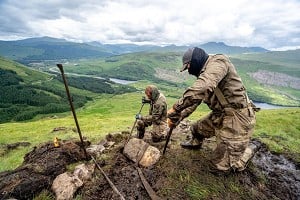
Fiddling around with a double fisherman's with cold hands and fading light the other day got me thinking about using the EDK (double overhand) for loops of cord in abseil anchors (in abalakovs, around rock spikes...). As far as I can see, the load directions and forces the knot would be subject to in a loop are similar to those in the (recommended) EDK joining two ropes, where one of which is threaded directly through the abalakov/thread or around the spike. And yet I've never heard of this knot being used in lieu of the double fisherman's, even with healthy tails. What gives?
It's standard practice in Europe.
I guess the common choice of EDK for abseiling off isn't purely about whether it can take the load. The EDK is also good for abseiling because it can be untied again fairly easily and its asymmetric shape helps it sit away from the rock and avoid jamming
It's not quite as strong as, say, a double fisherman's but it's strong enough and has those other advantages that are key for abseiling. For the loops of cord, those other advantages of the EDK aren't relevant so absolute strength becomes the main metric and knots like the double fisherman's win on that.
I'm also not sure whether the diameter of cord has an impact on how easily the EDK would slide or roll. I'd certainly be nervous about using it in cord but I don't know whether that's justified. You'd certainly want very long tails on it, which wouldn't be necessary with a double fisherman's.
I agree with the first part of your analysis, but the DF doesn't win on speed or fiddliness, and loads on abseil anchors are very low in any case. If it's standard practice in Europe as Jim says (not in Spain, in my experience, but perhaps elsewhere), then that's enough to make it the new standard for me!
My usual is an overhand knot backed up with another overhand knot if I'm feeling anxious.
Overkill or not, even two overhands is faster than the DF (I really have it in our our poor mariner friend, it seems).
To give it some credit, if tat weight is critical, the EDK tails probably require more than the DF (even if the knot itself is more frugal).
I believe that in tests the DF is stronger than the overhand and more reliable than the overhand but for these applications (abseil tie offs) the overhand is more than adequate and has some advantages (easier, quick and for ropes lies flat).
If you've got time the DF is better for things like slings or prussiks because it is stronger and more ascetically pleasing on your rack .
Absolutely, I will continue to use it for my pretied prussiks - the EDK tails would be bothersome there. It's a perfectly neat, strong and elegant knot (still just overhands after all, but in a different orientation). Just slow and fiddly. Glad to have advanced.
A major safety benefit of the single overhand knot (I refuse to call it EDK) with long tails is that it sits proud of features it runs over making it much less likely to snag when pulling. A jammed rope on multi abseils can lead to a very serious situation. Adding superfluous “back up” knots will only increase likelihood of jamming.
Of course. It was the other one I was having a go at.
I think EDK has become a term of endearment (memorable precisely because of the inherent contradiction; good knot, scary name), misleading as it is if spelled out given that the American Death Triangle is a deadly construction. Still, SOK could work too.
I left some in situ rope at a crag last year to ab off, my friend tied with an EDK. Like you, I hadn't seen that tied that way but thought why not.
The only downside I sensed was having what feels like a flimsier knot for something in situ someone else may come along and use. But that might also be bollocks and it works great this way.
> I'm also not sure whether the diameter of cord has an impact on how easily the EDK would slide or roll. I'd certainly be nervous about using it in cord but I don't know whether that's justified. <
FWIW my wife's art club have taken up my suggestion of using a single EDK in an American death triangle arrangement in 1.5/2.0 mm polyprop, plaited cord for hanging pictures in their exhibition. Testing with even badly dressed knots and quite heavy pictures was fine with no knot slippage. The single, really simple knot should prove better than last year's nylon fisherman's monofilament with two bowlines, which resulted in smashed works, especially as it is tied by people with no experience of knots.
IMHO the EDK seems entirely adequate for this purpose though personally I've always used double, or just single, fisherman's.
Incidentally I have noticed EDKs on ab tat in the UK a couple of times. One thing I don't know is if the EDK would be trustworty with nylon tape (I suspect not), but then I've only seen sewn tape slings or tied cord/rope left as tat in recent years anyway.
In First Creek Canyon in Red Rocks there is a slabby multi-abseil descent where the rope runs over featured convex rock. I've use both main knots there numerous times and the double fishermans I once used regularly has snagged several times and the overhand I've moved over to has never snagged.
If anyone who doubts the benefit of the EDK is ever faced with multiple abseils down a steep face in rising storm conditions, like I once was half way up the Eiger, they would very soon be convinced otherwise.
Al
We are discussing tying the ab tat, not the ropes.
It's normal ln Europe because climbers have been tying threads this way for generations, tying a DF with one hand isn't easy.
Next year use a macrame knot to make the works easily releasable when the exhibition ends.
When abseiling on double ropes the load is shared between both of them so the knot is only loaded with half your weight. The abseil tat however will have all your weight on it and possibly your partner's weight too, so potentially four times the load. A rethreaded overhand knot might be the best compromise between strength, economy and ease of tying.
If using unsheathed dyneema a triple fisherman's should be used due to its low friction coefficient. Overhand knots pull apart very easily with dyneema.
> When abseiling on double ropes the load is shared between both of them so the knot is only loaded with half your weight. The abseil tat however will have all your weight on it and possibly your partner's weight too, so potentially four times the load. A rethreaded overhand knot might be the best compromise between strength, economy and ease of tying. <
Is that correct? The tat has two sides coming down to the point where the ab rope passes through it/krab, thus much the same as the two sides of the ab rope joined by just one knot ie both tat and ab rope are only loaded with half the weight. (Obviously width of anchor giving perhaps a weaker triangle, and strength of tat vs rope are other factors. And weight of partner could also double it as you say.) Incidentally I'm no engineer and may well be wrong.
Presumably your rethreaded overhand is the same as overhand on the bight (which is how I would probably tie it for speed in a length tat).
I see your point.
It's an overhand knot tied in one end of the cord then rethreaded so that you have one end coming out from either side of the knot.
More pertinently, as long as you're using cord that's thicker than about 4mm, doubling the load will have an absolutely inconsequential effect on the potential for failure. I'm constantly amazed at how many people seem to regard knot strength as an important factor in knot choice when all reasonable knot options, if tied correctly, are many times stronger than required.
To me that's a water knot or tape knot (when tied in tape) and I believe its also called a competition knot, which when used for tying on may have advantages eg in ease of undoing over fig of 8 (never used it myself. All very confusing to me as rethreading in the other direction (as also when tying on with fig 8) gives the same final knot as overhand on the bight!
Why on earth wouldn't anyone use anything othèr than a single overhangs for joining two ropes in a static load scenario?
Sticking to rappel tat and not joining climbing ropes, I think the is at least something to think about with both the EDK and the ring bend in webbing. Both of these knots do something under periodic loading that shortens the tails. The EDK rolls, the ring bend just creeps. So although an an anchor may be just dandy for the folks who installed it, over time, with lots of use, the knot might get itself into a dangerous state and actually fail. In the case of the EDK, Moyers original tests included some on soaked ropes that experienced rolling at relatively low loads.
This leads me to a pair of conclusions. (1) Concern for fellow climbers means I'm going to leave a highly stable knot if I have to leave knotted slings. This means a double fisherman's knot in both cord and webbing. (2) I'm going to take a long hard look at any knotted slings to see where the tails are, and replace anything which was either tied too short to begin with or has crept into a sketchy state.
I have yet to find an EDK-tied sling I thought needed to be redone, but have over the years found several ring bends with an end barely outside the knot.
Re the water knot for abseil tat (on slings, might not be that much pertinent for cord), there had been some documented (even got to court in Germany I think) cases of it coming undone by part of it catching on very small flakes or protrusions of the slinged rock. Mostly while top roping or rescue training as part of anchors, but it happened.
> I was climbing last year with a guide/instructor and that's what we used for a long series of abseils. This was in Norway
Is this confusing the knot used to join the abseil ropes together with the Knot joining tat for abbing?
Yet another variation on use of overhand knot. I have a length of nylon tape with an overhand on bight loop at each end (similar to a commercial item (Snake?)) with a sewn loop at each ends. I've used it occasionally for a long attachment, eg to an abseil stake on sea cliffs to save my long slings for climbing, and it can be shortened with the krab for the rope going through both loops.
However I remember reading that used in its long form it is either weak or the knot slips (can't remember which), possibly since just one of the two "tails" of the knot is loaded. I don't use it much and not particularly useful. I suppose the same system using accessory cord would be better.








